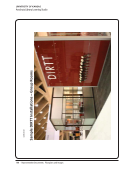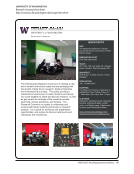SPEC Kit 327: Reconfiguring Service Delivery · 35
The combined desk allowed users to access services on the same floor as the Chapman Learning Commons (Example
2), simplifying the referral process by having service points closer. This service philosophy was more user-centered in
that it emphasized access and visibility over historical organizational structures.
The decision to close the LIS Library was taken within the broader context of the discussion of service needs explored as
part of our New Service Models program. Among the distinctive aspects of the LIS Library example were the growth of
interdisciplinary approaches to LIS teaching and research, the growth of the LIS teaching and research mission beyond
the traditional focus of the LIS Library on professional librarianship, and the increasing significance of distance learning
and e-learning programs in LIS programs on campus.
The former library space is now a hybrid of embedded and traditional librarianship, accommodating reference and
instruction but not circulation or tech services. This has freed up tremendous amounts of staff time to explore new
services: videos, more online tutorials, providing a newsletter, much more consulting, etc. The staff that remain no
longer have to check-out or shelve books. The focus is more on subject librarian tasks and materials selection.
The Head of Reference &Instructional Services had been following the information commons model and advocating
that this was a logical direction for the library to move in addressing the need to renovate the library’s first floor and
services. The first floor housed a very large and increasingly less used print reference collection. Print reference collection
reduced by four-fifths. After consultation with library staff, decision was made to continue providing walk-up reference
service in reconfigured space among offered services.
The library wished to provide a more accessible, centrally located service point that offers a broader range of services
in one location. By creating this point, we were able to move circulation to a high-traffic area on the main floor of the
library, as well as free up space in the previous location for future service development.
The opening of the TFDL comes after 12 years of the Library, Archives, Museum, and Press being part of the same
organizational family. The facility will enable an acceleration of the convergence of these units. We need to provide new
and different services to support our researchers and learners in taking full advantage of all the potential of the new
facility and will need to have our academic staff practicing more outreach. Support staff, paraprofessionals, and student
assistants will be available at the first point of contact, users are encouraged to use self-service options wherever
they are available, and a simplified and expedited referral process will be available to provide more in-depth research
assistance. At the point of writing, we are still in transition and cannot yet articulate the impact.
The other factor that led to the decision to close the computer lab service desk was that it was not staffed the same
hours as the Reference Desk, further increasing the confusion about the purpose of the desk and role of the staff who
worked there.
The library’s strategic plan focused on meeting students where they are, so the thought was combining would make it
less confusing which desk to go to for help.
These changes emerged from the work of our New Models of Service Task Force. They recommended fewer, more
consolidated service points as a way to free up librarians and staff to be more integrated in the workflow of our users,
including expanded teaching and consultation as well as the provision of virtual services. We were also informed in our
planning by a campus study of what characteristics students sought in informal learning spaces.
Usage of services at the reference desk and circulation desk had declined over the past few years. By consolidating those
services, we were able to reassign librarians new responsibilities that were being requested by library users.
Use of three collections (maps, microfilms, and “hard copy” reserves) was dwindling, while use of the media collection
(especially CDs and DVDs) was growing. There was anecdotal evidence (and certainly indications in library literature)
that users might prefer to access all of these special format (or short-term loan) items from a single service point.
The combined desk allowed users to access services on the same floor as the Chapman Learning Commons (Example
2), simplifying the referral process by having service points closer. This service philosophy was more user-centered in
that it emphasized access and visibility over historical organizational structures.
The decision to close the LIS Library was taken within the broader context of the discussion of service needs explored as
part of our New Service Models program. Among the distinctive aspects of the LIS Library example were the growth of
interdisciplinary approaches to LIS teaching and research, the growth of the LIS teaching and research mission beyond
the traditional focus of the LIS Library on professional librarianship, and the increasing significance of distance learning
and e-learning programs in LIS programs on campus.
The former library space is now a hybrid of embedded and traditional librarianship, accommodating reference and
instruction but not circulation or tech services. This has freed up tremendous amounts of staff time to explore new
services: videos, more online tutorials, providing a newsletter, much more consulting, etc. The staff that remain no
longer have to check-out or shelve books. The focus is more on subject librarian tasks and materials selection.
The Head of Reference &Instructional Services had been following the information commons model and advocating
that this was a logical direction for the library to move in addressing the need to renovate the library’s first floor and
services. The first floor housed a very large and increasingly less used print reference collection. Print reference collection
reduced by four-fifths. After consultation with library staff, decision was made to continue providing walk-up reference
service in reconfigured space among offered services.
The library wished to provide a more accessible, centrally located service point that offers a broader range of services
in one location. By creating this point, we were able to move circulation to a high-traffic area on the main floor of the
library, as well as free up space in the previous location for future service development.
The opening of the TFDL comes after 12 years of the Library, Archives, Museum, and Press being part of the same
organizational family. The facility will enable an acceleration of the convergence of these units. We need to provide new
and different services to support our researchers and learners in taking full advantage of all the potential of the new
facility and will need to have our academic staff practicing more outreach. Support staff, paraprofessionals, and student
assistants will be available at the first point of contact, users are encouraged to use self-service options wherever
they are available, and a simplified and expedited referral process will be available to provide more in-depth research
assistance. At the point of writing, we are still in transition and cannot yet articulate the impact.
The other factor that led to the decision to close the computer lab service desk was that it was not staffed the same
hours as the Reference Desk, further increasing the confusion about the purpose of the desk and role of the staff who
worked there.
The library’s strategic plan focused on meeting students where they are, so the thought was combining would make it
less confusing which desk to go to for help.
These changes emerged from the work of our New Models of Service Task Force. They recommended fewer, more
consolidated service points as a way to free up librarians and staff to be more integrated in the workflow of our users,
including expanded teaching and consultation as well as the provision of virtual services. We were also informed in our
planning by a campus study of what characteristics students sought in informal learning spaces.
Usage of services at the reference desk and circulation desk had declined over the past few years. By consolidating those
services, we were able to reassign librarians new responsibilities that were being requested by library users.
Use of three collections (maps, microfilms, and “hard copy” reserves) was dwindling, while use of the media collection
(especially CDs and DVDs) was growing. There was anecdotal evidence (and certainly indications in library literature)
that users might prefer to access all of these special format (or short-term loan) items from a single service point.






















































































































































































































